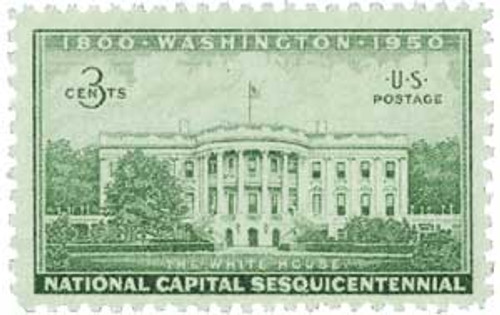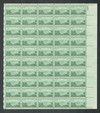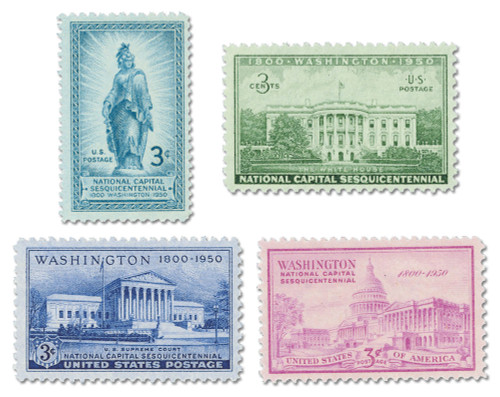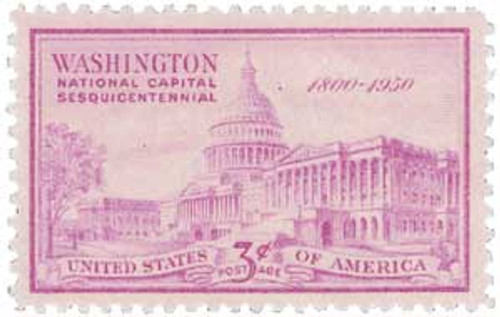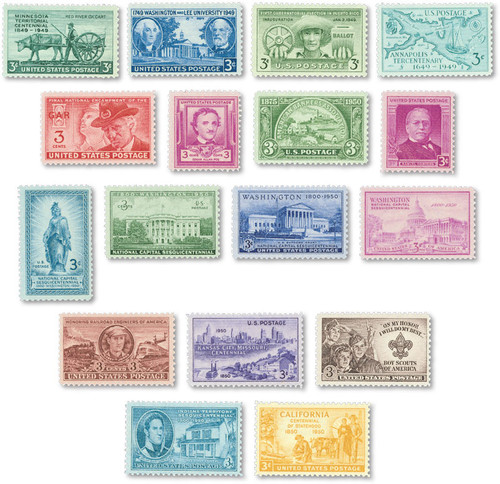
1950 3c National Capitol Sesquicentennial: Executive Mansion
# 990 - 1950 3c National Capitol Sesquicentennial: Executive Mansion
$0.35 - $23.50
U.S. #990
1950 3¢ Executive Mansion
National Capital Sesquicentennial Issue
Issue Date: June 12, 1950
City: Washington, D.C.
Quantity: 132,050,000
Printed By: Bureau of Engraving and Printing
Printing Method: Rotary Press
Perforations: 10 ½ x 11
Color: Deep green
U.S. #990 is part of the National Capital Sesquicentennial set, and honors the Executive branch of government as represented by the White House. The White House was planned by architect Francis Hoban and completed in 1802.
The planning of a new capital city known as the District of Columbia began during George Washington's administration. Construction of the "President's House" began in 1792, and the structure was close to completion in 1800. John and Abigail Adams were the first presidential couple to occupy the residence, which later would be officially named the "White House" by President Theodore Roosevelt.
Washington, D.C., was built in a vast wilderness, and Abigail Adams reportedly lost her way in the woods for hours during her first trip to the White House. The walls of the mansion were still wet, and fires burned in the fireplaces round the clock to help dry the drafty home. Many rooms were unfinished. Abigail hung the family's laundry in the East Room.
In spite of the primitive living arrangements, Adams understood that the mansion symbolized the seat of America's dedication to liberty. On his second night in the President's House, Adams wrote to his wife,"I pray Heaven to bestow the best Blessings on this House and all that shall hereafter inhabit it. May none but honest and wise Men ever rule beneath this roof". The words are inscribed on a mantel in the White House.
National Capital Sesquicentennial
A set of four U.S. stamps was issued in 1950 in honor of the 150th anniversary of the establishment of Washington, D.C., as the nation's capital. The stamps portrayed the three branches of government (Executive, Judicial, Legislative), as well as the concepts of Liberty and Freedom.
The idea that the capital be a district that was not part of any state was first put forth by James Madison, in Essay No. 43 of the Federalist Papers. The Compromise of 1790 resulted in the federal government assuming the war debt of the individual states in return for the placement of the national capital in the South.
A provision in the U.S. Constitution allowed for an area like a square of 10-mile sides. The land was donated by both Maryland and Virginia. The City of Washington and the Territory of Columbia were originally two separate entities, but in 1801, both the territory and the city (as well as neighboring cities Georgetown and Alexandria) were placed under the direct control of Congress. The federal government officially moved into the District in 1800.
U.S. #990
1950 3¢ Executive Mansion
National Capital Sesquicentennial Issue
Issue Date: June 12, 1950
City: Washington, D.C.
Quantity: 132,050,000
Printed By: Bureau of Engraving and Printing
Printing Method: Rotary Press
Perforations: 10 ½ x 11
Color: Deep green
U.S. #990 is part of the National Capital Sesquicentennial set, and honors the Executive branch of government as represented by the White House. The White House was planned by architect Francis Hoban and completed in 1802.
The planning of a new capital city known as the District of Columbia began during George Washington's administration. Construction of the "President's House" began in 1792, and the structure was close to completion in 1800. John and Abigail Adams were the first presidential couple to occupy the residence, which later would be officially named the "White House" by President Theodore Roosevelt.
Washington, D.C., was built in a vast wilderness, and Abigail Adams reportedly lost her way in the woods for hours during her first trip to the White House. The walls of the mansion were still wet, and fires burned in the fireplaces round the clock to help dry the drafty home. Many rooms were unfinished. Abigail hung the family's laundry in the East Room.
In spite of the primitive living arrangements, Adams understood that the mansion symbolized the seat of America's dedication to liberty. On his second night in the President's House, Adams wrote to his wife,"I pray Heaven to bestow the best Blessings on this House and all that shall hereafter inhabit it. May none but honest and wise Men ever rule beneath this roof". The words are inscribed on a mantel in the White House.
National Capital Sesquicentennial
A set of four U.S. stamps was issued in 1950 in honor of the 150th anniversary of the establishment of Washington, D.C., as the nation's capital. The stamps portrayed the three branches of government (Executive, Judicial, Legislative), as well as the concepts of Liberty and Freedom.
The idea that the capital be a district that was not part of any state was first put forth by James Madison, in Essay No. 43 of the Federalist Papers. The Compromise of 1790 resulted in the federal government assuming the war debt of the individual states in return for the placement of the national capital in the South.
A provision in the U.S. Constitution allowed for an area like a square of 10-mile sides. The land was donated by both Maryland and Virginia. The City of Washington and the Territory of Columbia were originally two separate entities, but in 1801, both the territory and the city (as well as neighboring cities Georgetown and Alexandria) were placed under the direct control of Congress. The federal government officially moved into the District in 1800.

